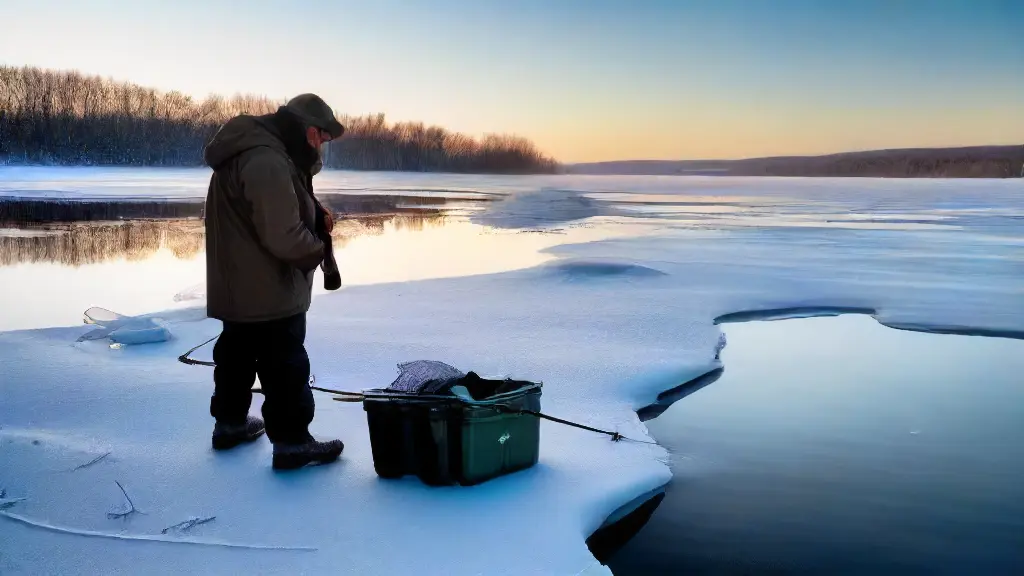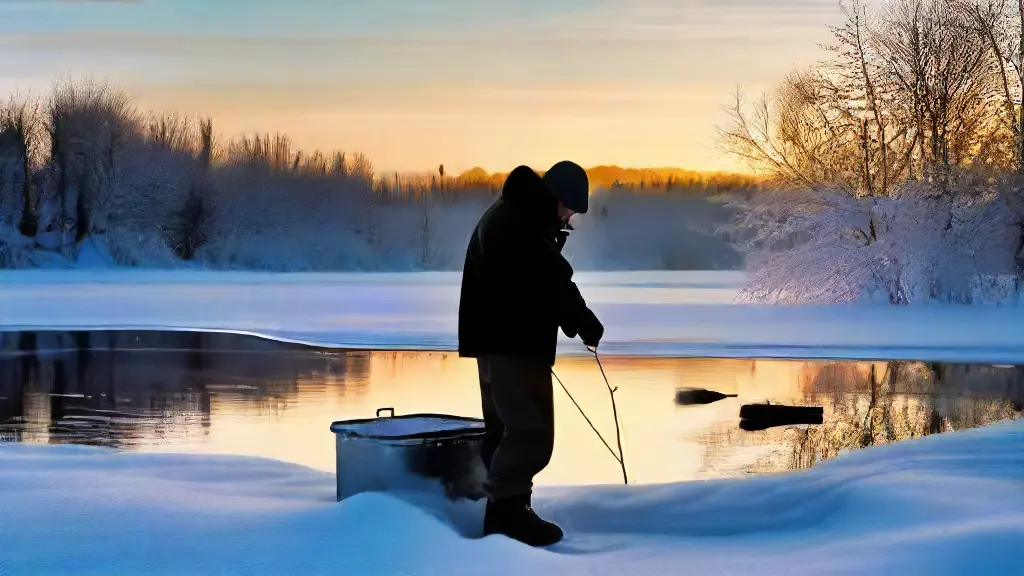Best Native Species for Winter Fishing

As the cold water of winter sets in, many anglers face the challenge of adapting to the changed fishing habits of their favorite species. With the right guidance, winter angling can be a thrilling experience.
When it comes to selecting the perfect live bait for a successful winter trip, native species are often the top choice.
- Prepare for a successful winter fishing trip by learning which native species make effective live bait.
Using native species as live bait offers several benefits over other types of bait. For one, they are more likely to be familiar to the fish in the area, making them more effective at enticing a bite. Using native species can be more environmentally friendly for trout fishing during winter seasons.
What Native Species Thrive in Winter
As the winter landscape transforms into a frosty domain, the waters beneath remain teeming with life. Frosty mornings and icy winds may seem unforgiving, but winter’s chill actually creates a unique environment that fosters a diverse array of aquatic life.
The key to successful winter fishing lies in understanding the habitats that native species call home during this time.
Cool-weather fish habitats, such as submerged vegetation near shore, rocky structures with depths ranging from 5-20 feet, and faintly stained or off-colour water, are particularly effective for attracting a variety of fish species.
From perch to walleye, several species thrive in winter, and proper selection of species is crucial for a successful day on the water. Perch, for instance, congregate near structure, using small invertebrates and worms as a food source, while targeting them with gear like hooks and lures that imitate aquatic crustaceans, minnows, shad, suckers, and leeches.

Why Use Live Bait in Winter Fishing
Winter’s presence on the water doesn’t have to mean a barren catch every time. In fact, the most effective fishing seasons often revolve around the use of live bait, providing anglers with a reliable means to reel in a bounty of fish.
The key lies in understanding when and how to utilize these bait options to maximum effect.
Determining the right winter fishing time frames is crucial.
For instance, many species of fish, such as perch and walleye, are more active during the early morning hours when the water is calm and there’s a slight bite of cold in the air. Conversely, species like pike and muskie often thrive in the warmer waters of late afternoon.
In the quest for winter fishing success, the right bait is essential. One of the most effective species for winter success is the humble crawdad, which can be used to catch everything from trout and panfish to walleye.
Winter Fishing Tips
- Many species of fish, such as perch and walleye, are more active during the early morning hours when the water is calm and there’s a slight bite of cold in the air.
- Conversely, species like pike and muskie often thrive in the warmer waters of late afternoon.
- The humble crawdad is one of the most effective species for winter success, and can be used to catch everything from trout and panfish to walleye.
- Live bait is a reliable means to reel in a bounty of fish during the winter fishing season.
When to Select Native Species
Winter’s chill brings unique challenges to anglers seeking to target native species, requiring a keen understanding of the environment and its subtle changes.
As the winter season approaches, anglers face a unique set of challenges when targeting native species in their favorite fishing spots.
I.
Seasonal Considerations
When it comes to selecting native species, it’s essential to assess the temperature fluctuations and oxygen levels, as these can significantly impact the fish’s behavior and feeding patterns.
Precipitation can also disrupt underwater vegetation, making it crucial to evaluate the type of aquatic structure present in the area.
II.
Time of Day and Fishing Techniques
During the winter months, dawn and dusk are often the most productive times for ice fishing, as fish tend to be more active during these periods. Employing the right fishing technique can also make a significant difference, such as using suspended baiting or catch-and-release methods that promote conservation and sustainable practices even in harsh weather conditions, including heavy precipitation, and considering the climate, temperature, wind, current, underwater structure, and vegetation.
How to Identify Effective Native Species
As the winter chill sets in, many anglers struggle to navigate the icy waters, but with the right approach, understanding native species can be the key to unlocking a successful fishing experience.
A native species is a fish that has evolved in a specific region or lake, developing unique characteristics that enable it to thrive in that environment.
Concealment is a vital aspect of their survival, allowing them to blend in with their surroundings, making them more difficult to spot.
Winter fishing often requires a different approach, as fish tend to congregate in specific areas, such as ambush points, using structures like rocks, weed beds, or sunken logs as cover.
Rigging your line with the right presentation is crucial to increase your chances of catching fish during the cold winter months. Let me know if you need any further refinements!.
Winter Fishing
- Fish tend to congregate in specific areas, such as ambush points, during winter months.
- Native species have evolved to blend in with their surroundings, making them harder to spot.
- Rigging your line with the right presentation is crucial for increasing your chances of catching fish during winter.
- Winter fishing often requires a different approach from other seasons, as fish behavior and habitats change.
What Factors Affect Native Species Populations
The intricate dance between species and their environments has long fascinated conservationists and scientists alike, yet the complex factors influencing native species populations often go unnoticed. As the world’s ecosystems face unprecedented threats, it’s essential to understand the diverse forces that shape the survival and persistence of these extraordinary organisms.
Environmental conditions play a significant role in shaping native species populations.
For instance, changes in water temperature can have a profound impact on fish populations and behavior.
A slight increase in temperature can disrupt the delicate balance of an ecosystem, affecting the distribution and abundance of fish species such as walleye and yellowperch.
.
Why Choose Aquatic Invertebrates for Winter Fishing
As the winter landscape transforms into a serene blanket of snow and ice, many fishermen trade in their rods for cozy nights by the fire. For those who venture out, the thrill of landing a prized catch can be a rewarding experience, and it’s not hard to find it in the cold, dark waters.
As the mercury drops, many anglers retreat to their cozy homes, but not the keen fishermen who choose to target aquatic invertebrates for their winter fishing escapades.
This fascinating group of organisms has evolved unique adaptations to thrive in the harsh, cold conditions.
Thermal Regulation:
Aquatic invertebrates have developed ways to regulate their body temperature, allowing them to stay active even in freezing waters. This includes behaviors such as burrowing into sediment or finding sheltered areas to reduce heat loss.
Invertebrate fish such as carp, sturgeon, bullheads, eel, lamprey, perch, sunfish, and bass thrive in their natural habitat of freshwater, where they play a vital role in the aquatic life and fish population, and are often sought after by wildlife and fish enthusiasts at specific fishing locations.
| Thermal Regulation | Unique Adaptations | Winter Fishing Targets | Freshwater Habitat |
|---|---|---|---|
| Burrowing into sediment or finding sheltered areas to reduce heat loss | Developed ways to regulate body temperature | Carp, sturgeon, bullheads, eel, lamprey, perch, sunfish, and bass | Freshwater, playing a vital role in aquatic life and fish population |
How to Present Native Species for Maximum Efficacy
As the pursuit of freshwater fishing continues to evolve, understanding the intricacies of presenting native species has become increasingly crucial for success. With so many factors at play, from the water’s temperature to the choice of bait, it’s easy to get caught up in the complexity of the process.
Picking the Right Species
When it comes to presenting native species for maximum efficacy, it’s essential to identify invertebrates that thrive in cold water.
Crustaceans such as crayfish and snails are excellent choices, as are insect larvae like lake flies and chironomids.
Preparing Invertebrates
Before presenting your invertebrates, it’s crucial to remove excess water and soak them in aquarium water. A gentle cleaning solution can also help to remove any debris or sediment. strong>Baiting the Hook When it comes to successful fish identification and conservation, a thorough understanding of fishing techniques and species migration patterns is crucial.
What Techniques Boost Native Species Success
In the intricate web of aquatic life, native species play a vital role in maintaining the delicate balance of fish distribution, adapting to subtle changes in fish phenology. Native species are often at the center of a delicate balance, where they play a vital role as both predator and prey, and their success is influenced by various environmental factors.
In this section, we’ll explore the techniques that can boost their success, enabling you to reel in a bountiful catch while contributing to the preservation of these remarkable species.
The ability to coexist with invasive predators is a testament to the resilience of native species, which have evolved unique fish morphology and anatomy to thrive in their fishecosystem.
Understanding their habits and behaviors is crucial for a successful winter fishing experience, as it allows anglers to develop effective fishing strategies that respect the fishpopulation dynamics. By adopting conservation-focused approaches that consider the complex relationships between fish, their predators, prey, ecosystem, community, distribution, abundance, population dynamics, phenology, biology, ethics, physiology, morphology, anatomy, and parasites,.
Native Species
- Native species play a vital role in maintaining the delicate balance of fish distribution.
- Their success is influenced by various environmental factors, including fish morphology and anatomy.
- Understanding their habits and behaviors is crucial for a successful winter fishing experience.
- Conservation-focused approaches consider the complex relationships between fish, their predators, prey, ecosystem, community, distribution, abundance, population dynamics, phenology, biology, ethics, physiology, morphology, anatomy, and parasites.
How to Use Native Species for Ice Fishing
How to Store Native Worms for Long-Term Use


